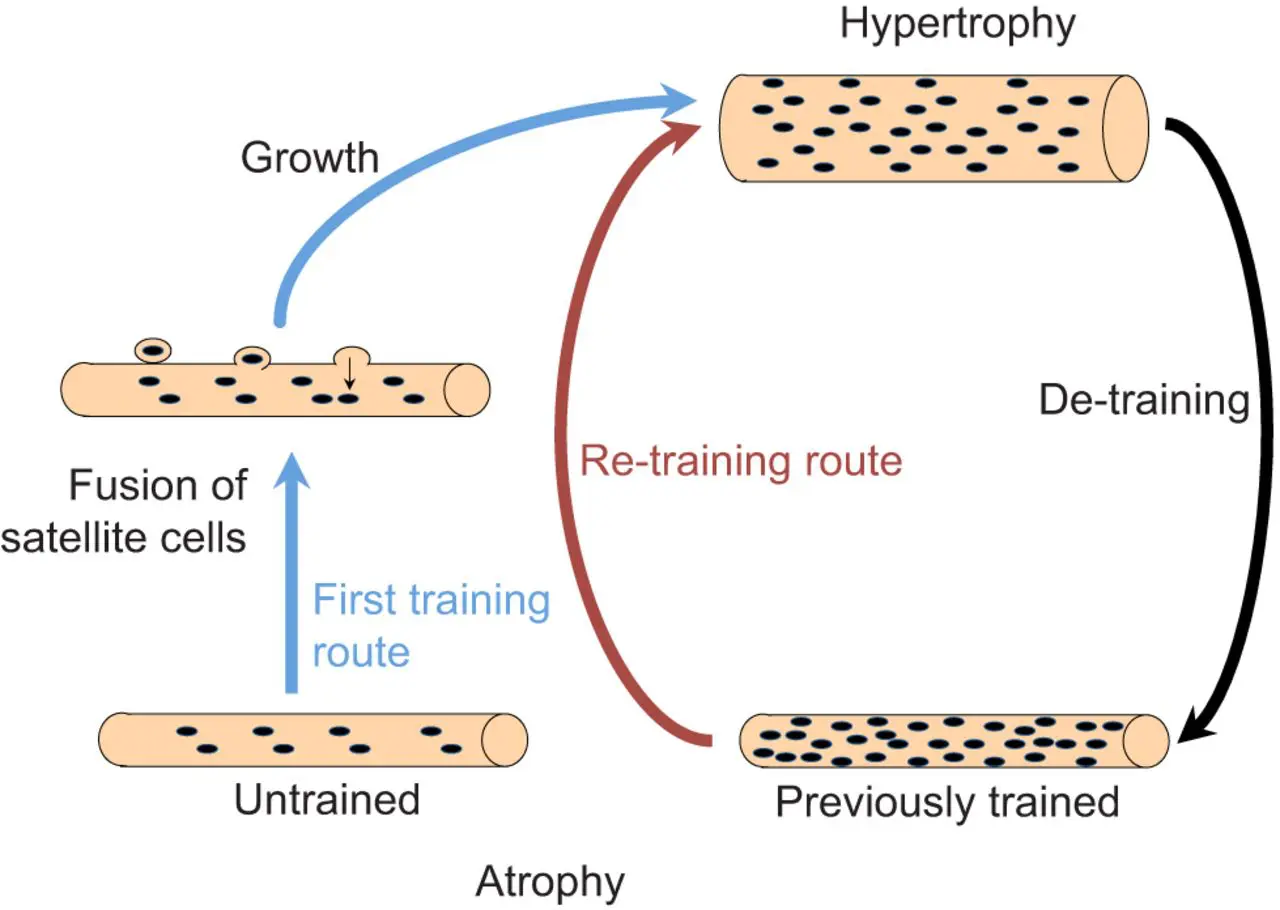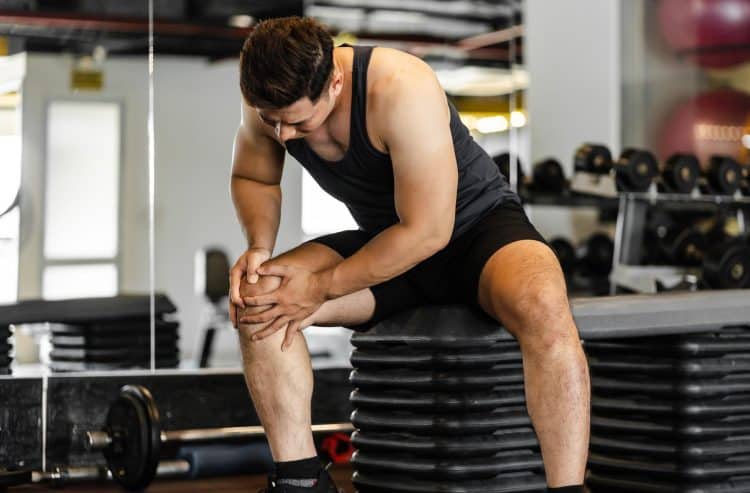It takes many months and even years to build significant levels of strength and muscle mass. You have to fight for every pound you gain, paying attention not only to your workouts but your diet and sleep strategies, too. You must also be consistent, hitting the gym like it’s your job. Missed workouts don’t build muscle!
Sure, some people build muscle more quickly than others. However, it’s still a relatively slow process, even for so-called easy gainers.
Sadly, you cannot “store strength,” and taking time off from training means your muscles will start to atrophy or shrink, gradually returning to their pre-trained state.
A week or two away from training won’t have much impact, and you should be able to return to the gym where you left off. But, skip your workouts for a few months, and loss of size and strength will be quite noticeable.
Again, some people lose muscle more slowly than others. Still, the sad fact is that you’ll gradually lose your gains if you quit working out for an extended period.
Because of this, many lifters are very reticent to take time off from training. They will only go on vacation if there is a hotel or nearby gym to use, and they’ll train through illness and injury to avoid losing muscle and strength. Not working out can also cause anxiety, as our lifter imagines they can see their muscles shrinking.
Level Up Your Fitness: Join our 💪 strong community in Fitness Volt Newsletter. Get daily inspiration, expert-backed workouts, nutrition tips, the latest in strength sports, and the support you need to reach your goals. Subscribe for free!
The good news is that, because of something called muscle memory, it’s often quicker to regain muscle than build it in the first place.
We reveal what muscle memory is and how you can use it to achieve and maintain your gains.
What is Muscle Memory?
A lot of the things that bodybuilders say and do are based on what is often referred to as bro science. These are concepts or strategies not based on research but are supported mainly by anecdotal evidence.
Examples of bro science include:
- You can shape a muscle by performing specific exercises
- You must train in the 6-12 rep range to build muscle
- Eating six meals a day is best for muscle building
- The more protein you eat, the more muscle you’ll gain
- Not eating immediately after training will hurt your gains
- Cardio “eats” muscle
- The only way to build muscle is with a split routine
- Freeweights are better than machines for muscle building
Bro science “facts” have often been exposed as myths. Scientific studies have shown, for example, meal frequency is not important, that you can build muscle with as many as 30 or more reps per set, there is no such thing as the “anabolic window,” and not eating straight after your workout won’t harm your gains.
However, some aspects of bro science HAVE been studied and proven to be true. One such example is the muscle memory phenomenon.
In simple terms, muscle memory refers to the concept that it’s easier to regain lost muscle than put on new muscle in the first place.
For example, if you trained for two years and then took a six-month break, muscle memory means it may only take four months to get back to your previous level of muscularity.
Of course, people gain and lose muscle at different rates, and these time frames are for illustration purposes only. However, plenty of scientific evidence supports the concept of muscle memory (1, 2).
Muscles seem to “remember” that they were once bigger and stronger and grow more quickly when you return to training after a layoff.
Mechanisms of Muscle Memory
There are a couple of different mechanisms at play in muscle memory.
Firstly, there are neurological factors. This is where your body learns how to perform the exercises in your workout and recruit your muscles in the best way to do the movements correctly.
If you think back to when you were a beginner, mastering the basic exercises took time. Poor initial technique meant your workouts were not as productive as they could have been. But, over time, your exercise performance improved, and your mind-muscle connection got stronger. As such, your workouts became more productive.
Muscle memory means that the neurological skills you need to bench press, squat, curl, etc., are hardwired into your neuromuscular system, so you don’t have to waste time re-learning how to do exercises in your workout. Your muscles might have regressed to beginner status, but your nervous system experiences far less detraining.
This is akin to learning to ride a bike or swim as a kid. You might not practice these skills for many years afterward, but you can still do them because your brain and muscles remember how to do them. The chances are you’ll never forget how to ride a bike or swim once you have learned. Similarly, you won’t forget how to squat or bench press, so your first few workouts after a layoff will be more productive than when you were a beginner.
The second factor of muscle memory is morphological, referring to changes within the muscle.
When you strength train, your muscles adapt by getting bigger and stronger. Muscle fibers thicken, which is a process called hypertrophy. They may also increase in number, which is called hyperplasia. However, the evidence for hyperplasia is not conclusive.
Read more: Hypertrophy vs. Hyperplasia.
In addition to becoming thicker, training also triggers an increase in the formation of myonuclei, which are control centers that affect different regions of the muscle fiber. Myonuclei are formed by satellite cells in response to intense strength training and are a precursor of muscle growth.
The more myonuclei in a muscle fiber, the greater the potential for hypertrophy. The longer you train, the more myonuclei you will develop.
Studies have revealed that myonuclei remain unaffected even if muscles atrophy from lack of use (2). As such, when you return to training, your muscles are already equipped for growth and undergo more rapid hypertrophy than they did the first time around.
It’s hypothesized that once built, myonuclei are protected and are not subject to apoptotic activity, meaning they do not atrophy like muscle cells. In fact, myonuclei may be so resistant to the effects of training breaks that they never go away (3).
It seems that the law of “use it or lose it” applies to muscle fibers but not myonuclei. This is excellent news for bodybuilders, powerlifters, and general strength trainers faced with prolonged breaks from training.
While your muscles may shrink, your neurological and morphological “hardware” do not, so you will be able to regain whatever strength and muscle mass you’ve lost much more quickly. Even long breaks lasting several years will not diminish your ability to regain lost muscle and strength.
Level Up Your Fitness: Join our 💪 strong community in Fitness Volt Newsletter. Get daily inspiration, expert-backed workouts, nutrition tips, the latest in strength sports, and the support you need to reach your goals. Subscribe for free!
So, if you got into good shape in high school, quit lifting when you left, and then returned to the gym in your 40s, you’d probably make better progress than if you had never trained before.
Muscle Memory – How to Use This Information
So, now we know what muscle memory is and the mechanisms behind it, how can we use this information? Let’s take a look!
Don’t fear layoffs
If you are worried about losing your gains during vacation or because you’re too busy to hit the gym, now you know you don’t need to be.
While your muscles may undergo some atrophy during a training break, you’re fully equipped to “bounce back” and rapidly regain your lost muscle mass. A couple of months of training should get you back to the level that potentially took many years to reach in the first place.
So, go on holiday and enjoy not training for a few weeks. The chances are that the rest will do you good!
It’s okay to skip training when you are ill or injured
Many lifters would rather train through illnesses and injuries to avoid losing muscle. While this can be okay in some circumstances, training when unwell or hurt could make you feel worse and delay your recovery.
While you can train around injuries, it’s worth noting that total rest may enhance healing, and it might be better to skip your workout until you’re on the mend. This is especially true if your injury forces you to lift lighter weights, do fewer reps, or modify your technique, which will compromise the quality of your workout.
Because of muscle memory, it’s okay to take a break from training when ill or injured. In fact, not working out means you might recover faster.
You can’t judge the effectiveness of a workout after a layoff
After a layoff, your body is primed to adapt and grow and will do so rapidly. What took you years to achieve the first time around could take a few short months.
While this is obviously a good thing, it also means that you cannot judge the effectiveness of your workout plan by these results, as they’re atypical. You’re back to being a beginner, which means almost any workout will produce muscle hypotrophy and strength gains.
So, don’t assume you’ve found the holy grail of workouts just because you build muscle faster than before. It’s NOT your training plan but muscle memory that’s responsible for your new growth spurt.
Periodic training can produce similar gains to constant training
Some people are habitual exercisers, while others are more inconsistent and, because of work or family commitments, find it hard to maintain a regular workout schedule. Military personnel are often in this situation and can train when they’re back in their home barracks but are forced to take breaks during deployments.
Because of muscle memory, it seems that it may still be possible to build and achieve significant levels of strength and muscle mass even if you are unable to train consistently.
In a Japanese study, participants either trained for six months continuously or followed a six-weeks on/three-week off periodic program for six months.
As you would expect, the periodic group lost muscle during their breaks but quickly regained it when they returned to training. At the end of the study, both groups had made similar muscle gains (4).
Muscle Memory FAQs
Do you have a question about muscle memory? No problems because we’ve got the answers!
1. So, how long does muscle memory last?
Studies suggest that muscle memory lasts at least a few months and possibly forever (5). Why such a vague timeframe? It’s basically because most studies into muscle memory only last 6-12 months. While it is very likely that once built, myonuclei last forever, no studies currently support this.
So, suffice it to say, muscle memory will probably last long enough that you can take a lengthy break from training and still bounce back quicker, even if you’re away from the gym for several years.
2. How quickly do atrophy and detraining start to happen?
While people lose muscle at different rates, atrophy and detraining tend to set in within 2-3 weeks of your last workout. So, a one-week break from training probably won’t have any noticeable effect. However, taking 2-3 weeks off will start to see some loss in strength and muscle size. The longer you are off, the more you’ll lose.
However, it’s worth noting that the more experienced you are, and the longer you’ve been training, the slower atrophy and detraining tend to be. Beginners usually lose their gains faster.
That said, because of muscle memory, you will soon regain lost muscle and strength when you return to training.
3. How often do I need to train to prevent atrophy and detraining?
You don’t need to do a lot of training to avoid muscle atrophy. In fact, one full-body workout per week is probably enough to maintain your current gains (6). So, even if you are really busy and cannot make it to the gym more often, commit to one workout per week to maintain your gains until you can return to your regular training schedule.
4. Will I be sore after a break from training?
Have you heard the expression, “the mind is willing, but the body is weak?” That could easily have been written about muscle memory!
After a layoff, your muscles are deconditioned, and your training tolerance is low. However, your nervous system still knows how to perform the exercises in your workout. Also, you will have certain expectations about what and how much training you can do, which are based on what you USED to do.
As such, it’s not uncommon to do more training than you should when returning from a layoff. Needless to say, this results in severe delayed onset muscle soreness or DOMS.
The best way to avoid this is to rein in your enthusiasm and do far less for your first few workouts than you used to do. A couple of exercises and sets per muscle group should suffice. Think of yourself as a beginner, albeit one with lots of previous experience.
Because of muscle memory, you’ll soon be capable of longer, more intense workouts, but rushing the process could leave you crippled with muscle soreness.
5. How fast will I regain lost muscle and strength after a layoff?
Unfortunately, this is one question we are unable to answer. That’s because many factors affect the rate of muscle regain after a training break.
For example:
- The longer you’ve been lifting, the slower you lose muscle
- Younger people tend to regain muscle faster than older people
- Some lifters lose more muscle than others or naturally build muscle more quickly
- The length of your layoff will also affect how much muscle you lose
- Things like your diet and recovery strategies impact the speed of muscle regain
However, regardless of all these considerations, it’s safe to say you will rebuild muscle faster than you built it in the first place. So, be patient, work hard, and enjoy your rapid progress.
Muscle Memory – Closing Thoughts
Unlike quite a lot of bro science, muscle memory is real. Because of the long-term neurological and morphological effects of strength training, you can rebuild muscle faster after a layoff than when you built it the first time.
This is excellent news for anyone who is reticent to take a break from training or feels they have to train through illnesses and injuries to preserve their gains. It’s also reassuring to know that if you are forced to take a break, you will be able to get back to your previous level relatively quickly, even if that break is quite long.
References
- Seaborne RA, Strauss J, Cocks M, Shepherd S, O’Brien TD, van Someren KA, Bell PG, Murgatroyd C, Morton JP, Stewart CE, Sharples AP. Human Skeletal Muscle Possesses an Epigenetic Memory of Hypertrophy. Sci Rep. 2018 Jan 30;8(1):1898. doi: 10.1038/s41598-018-20287-3. PMID: 29382913; PMCID: PMC5789890.
- Bruusgaard JC, Johansen IB, Egner IM, Rana ZA, Gundersen K. Myonuclei acquired by overload exercise precede hypertrophy and are not lost on detraining. Proc Natl Acad Sci U S A. 2010 Aug 24;107(34):15111-6. doi: 10.1073/pnas.0913935107. Epub 2010 Aug 16. PMID: 20713720; PMCID: PMC2930527.
- Schwartz LM. Skeletal Muscles Do Not Undergo Apoptosis During Either Atrophy or Programmed Cell Death-Revisiting the Myonuclear Domain Hypothesis. Front Physiol. 2019 Jan 25;9:1887. doi: 10.3389/fphys.2018.01887. PMID: 30740060; PMCID: PMC6356110.
- Ogasawara R, Yasuda T, Ishii N, Abe T. Comparison of muscle hypertrophy following 6-month of continuous and periodic strength training. Eur J Appl Physiol. 2013 Apr;113(4):975-85. doi: 10.1007/s00421-012-2511-9. Epub 2012 Oct 6. PMID: 23053130.
- Gundersen K. Muscle memory and a new cellular model for muscle atrophy and hypertrophy. J Exp Biol. 2016 Jan;219(Pt 2):235-42. doi: 10.1242/jeb.124495. PMID: 26792335.
- Bickel CS, Cross JM, Bamman MM. Exercise dosing to retain resistance training adaptations in young and older adults. Med Sci Sports Exerc. 2011 Jul;43(7):1177-87. doi: 10.1249/MSS.0b013e318207c15d. PMID: 21131862.















